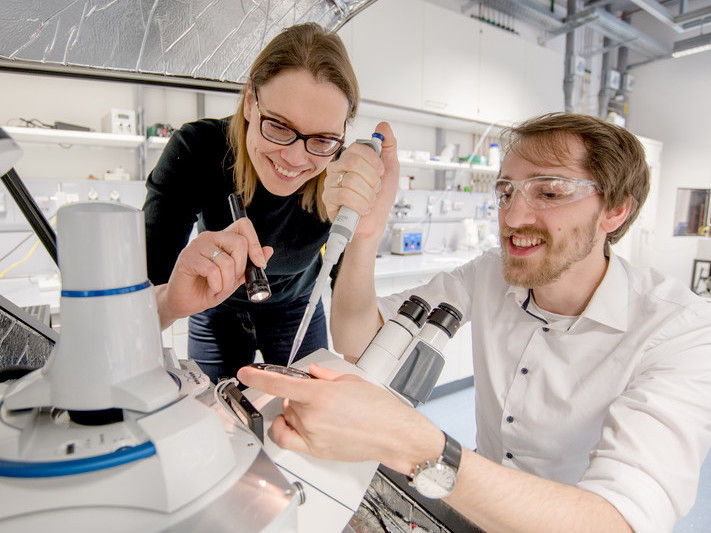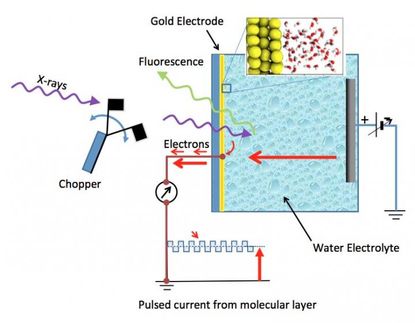Applying precious metal catalysts economically
Precious metal nanoparticles of platinum and gold are excellent catalysts. But they are expensive and rare. This new method makes it possible to save material.

Kristina Tschulik and Mathies Evers develop methods that help to use rare and expensive precious metal nanoparticles as sparingly as possible for catalysis.
© RUB, Marquard
Researchers at Ruhr-Universität Bochum and the Fritz Haber Institute Berlin have developed a new method of using rare and expensive catalysts as sparingly as possible. They enclosed a precious metal salt in outer shells, tiny micelles, and had them strike against a carbon electrode, thus coating the surface with nanoparticles of the precious metal contained in the micelles. At the same time, the team was able to precisely analyse how much of the metal was deposited. The researchers then showed that the electrode coated in this manner could efficiently catalyse the oxygen reduction, which is the limiting chemical process in fuel cells.
Producing particles of the same size
The research group produced the gold nanoparticles with the help of micelles. The particles initially consisted of a precursor substance, chloroauric acid, which was wrapped in an outer polymer shell. The benefit: “When we produce gold nanoparticles using micelles, the nanoparticles are all of an almost identical size,” says Kristina Tschulik, a Principal Investigator of the Cluster of Excellence Ruhr Explores Solvation (Resolv). Only a certain load of the precursor material, from which a single particle of a certain size is produced, fits inside the small micelles. “As particles of different sizes have different catalytic properties, it is important to control the particle size by means of the load quantity of the micelle,” adds Tschulik.
Uniform coating, even on complex surfaces
To coat the cylindrical electrode, the researchers immersed it in a solution containing the loaded micelles and applied a voltage to the electrode. The random motion of the micelles in the solution caused them to strike against the electrode surface over time. There, the outer shell burst open and the gold ions from the chloroauric acid reacted to form elemental gold, which adhered to the electrode surface as a uniform layer of nanoparticles. “Only flat substrates can be coated uniformly with nanoparticles using standard methods,” explains Tschulik. “Our process means that even complex surfaces can be loaded uniformly with a catalyst.”
Separated quantity precisely controllable
While the gold ions from the chloroauric acid react to form elemental gold, electrons flow. By measuring the resulting current, the chemists can determine exactly how much material was used to coat the electrode. At the same time, the method registers the impact of each individual particle and its size.
The researchers successfully tested the oxygen reduction reaction of the electrodes coated using the new process. They achieved an activity as high as that of naked gold nanoparticles without an outer shell. Due to the uniform coating of the surface, they also observed a reaction rate almost as high as that of electrodes completely covered with gold and solid gold electrodes at just eleven percent coverage.
Original publication
Other news from the department science
These products might interest you

NANOPHOX CS by Sympatec
Particle size analysis in the nano range: Analyzing high concentrations with ease
Reliable results without time-consuming sample preparation

Eclipse by Wyatt Technology
FFF-MALS system for separation and characterization of macromolecules and nanoparticles
The latest and most innovative FFF system designed for highest usability, robustness and data quality

DynaPro Plate Reader III by Wyatt Technology
Screening of biopharmaceuticals and proteins with high-throughput dynamic light scattering (DLS)
Efficiently characterize your sample quality and stability from lead discovery to quality control

Get the chemical industry in your inbox
By submitting this form you agree that LUMITOS AG will send you the newsletter(s) selected above by email. Your data will not be passed on to third parties. Your data will be stored and processed in accordance with our data protection regulations. LUMITOS may contact you by email for the purpose of advertising or market and opinion surveys. You can revoke your consent at any time without giving reasons to LUMITOS AG, Ernst-Augustin-Str. 2, 12489 Berlin, Germany or by e-mail at revoke@lumitos.com with effect for the future. In addition, each email contains a link to unsubscribe from the corresponding newsletter.



























































